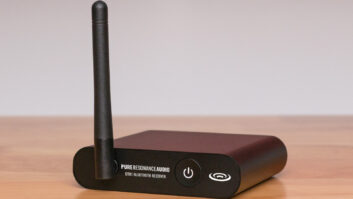At some point, every engineer needs to measure audio. Audio test instruments have traditionally been cumbersome and expensive, but progressing technology has made these instruments more readily available. One example is Phonic’s PAA3 ($469.99), a portable audio analysis instrument that operates via battery or AC.
A built-in microphone facilitates measurement of SPL (30 to 130 dB), RT60 (up to 30 seconds) and 31-band RTA, while a line input measures voltage (5 millivolts to 80 volts), dBu (-50 to +40) and dBV (-52 to +38). A USB data port enables simultaneous use with any PC supporting Windows 98 and above, providing real-time control and viewing of PAA3 data.
In addition to a USB port, the PAA3’s external features include a side-mounted data wheel, XLR line-level I/O and a jack for the wall wart power supply (included). The front panel is home to a backlit 160×160 LCD. Below the LCD are four push-buttons used to turn the PAA3 on/off and navigate the various menus. The rear of the unit has a pivoted microphone, a master on/off switch, a contrast wheel for the LCD and a socket for stand mounting. A slide-out door provides access to the battery compartment (four AAs). To turn the unit off, hold the Power button until the backlight blinks.
AUDIO EXPERT
The PAA3 is great for SPL and frequency analysis. Upon boot up, the unit defaults to a screen showing 31-band RTA and numeric and bar graph indication of SPL. The top of the display shows range, weighting (A, C or none) and peak SPL. The numeric display’s left-half defaults to ALL, meaning that the PAA3’s numeric readout is showing average SPL across the audio range.
Rotating the data wheel or using the up/down push-buttons alters the numeric display to show specific SPL at any of the standard ⅓-octave bands from 20 to 20k Hz. (The selected bar blinks.) This is a necessary feature because the spectrum display’s frequency axis is marked every three octaves, making it difficult to pinpoint the “in-between” values, and the RTA always shows vertical divisions of 10 dB regardless of the SPL range. It would be nice to have the ability to change that scale to 5 dB for higher resolution.
A push of the left-most Enter button provides access to a menu with pages for input (SPL or line), RT60, memory, settings, phase check, internal generator and power. To access a menu, scroll using either the up/down buttons or the data wheel and press Enter. An escape option returns the menu to the previous page. The SPL/Line menu switches between acoustic and electrical measurements; the range and numeric indicators reflect the appropriate measurement unit.
OUTSTANDING IN THE FIELD
Using the PAA3 to measure reverb time in a medium-sized live room and a church was a breeze. Once you’ve accessed the RT60 menu, simply select Run and press Enter. The PAA3 evaluates average background noise and waits for a transient signal with a decay range greater than 30 dB. (I used a hand clap.) Once it hears that signal, it measures the decay time and displays the result in seconds. Ten measurements can be stored and recalled, and the PAA3 can average the readings, making it possible to measure various sections of the church and come up with an average reverb time.
I also used the PAA3’s spectrum analyzer to generate a complementary “flat response” curve for a 31-band, ⅓-octave EQ. This required playing pink noise from the PAA3’s line out through the P.A. system. While accessing the Memory menu, RTA and pink noise continue to run in the background, so I was able to walk to different areas of the room, take RTA measurements and store the results into several of the unit’s 10 numbered memory slots. (The PC software allows you to name these locations, but names cannot be uploaded to the PAA3.) I could then choose any or all of these readings for averaging and store the average into additional registers.
Choosing EQ Setting from the PAA3’s menu displayed a graph of the suggested settings for the 31-band EQ that would flatten out the room, based upon the average response curve. Very cool!
I used Phonic’s supplied PC software during live shows when my hands were full (of faders) and needed a larger display. Information stored in the PAA3 is instantly uploaded to the PC, and the computer screen displays RTA with bright graphics that are easy to see alongside a console while mixing. Any function accessed on the PAA3 is mirrored on the PC and vice versa — with one exception: In the PC software, clicking on the SPL Meter indicator turns the display into a large SPL-only meter. This cannot be accessed via the handheld.
THE VERDICT?
My gripes with the PAA3 are minor. A gas tank meter would be more helpful than a flashing low-battery indicator, and it would be great if the PAA3 could source power via USB when connected to a PC. Regardless of minor quibbles, the PAA3 is invaluable for any engineer. Along with headphones, earplugs and a test CD, it quickly became part of my standard pack for sessions and live shows. The PC software is a home run, so much so that I’m looking for virtual PC software to run it on my Mac.
Phonic, 813/890-8872, www.phonic.com.







